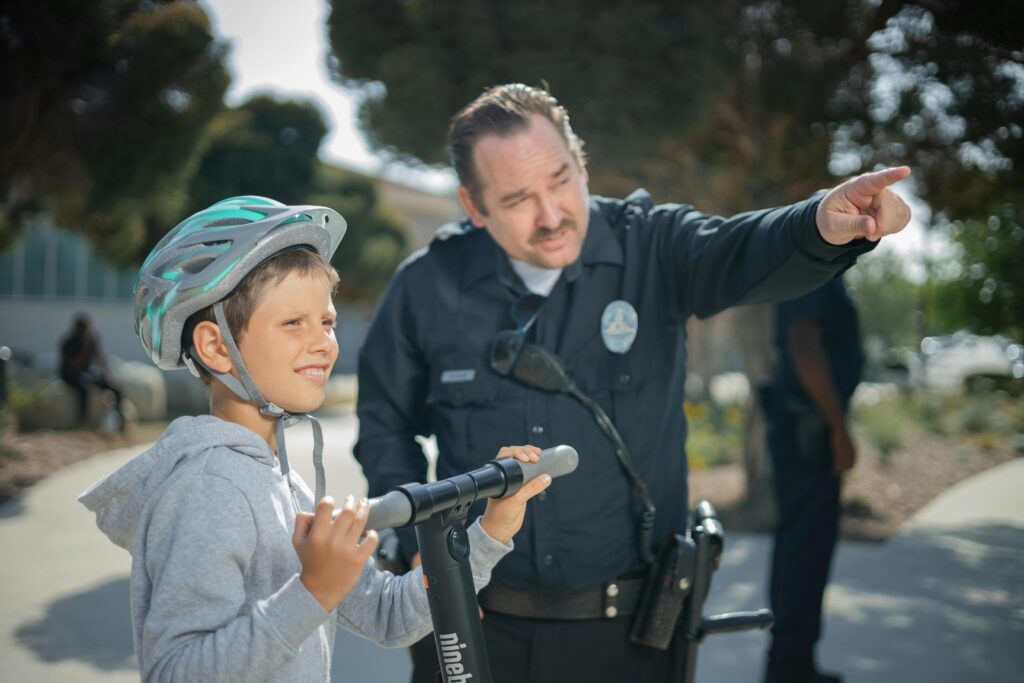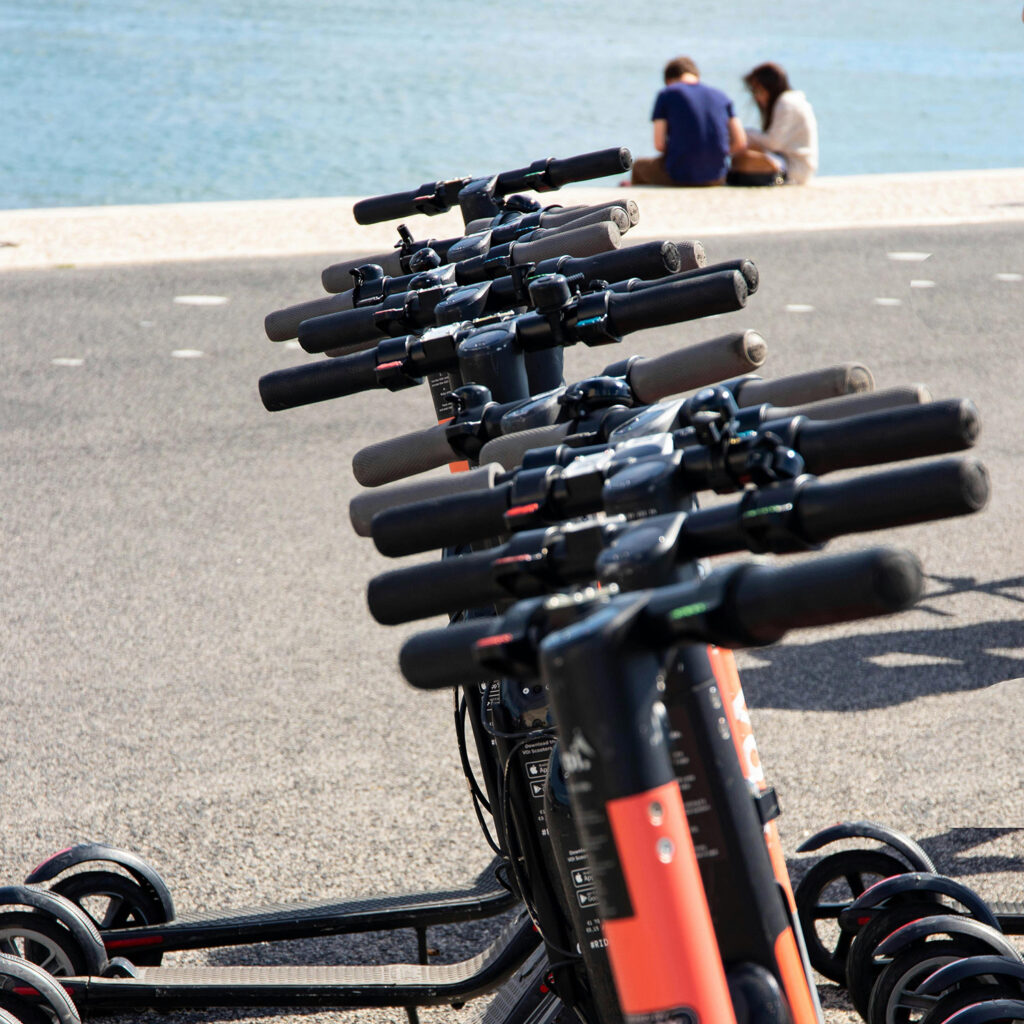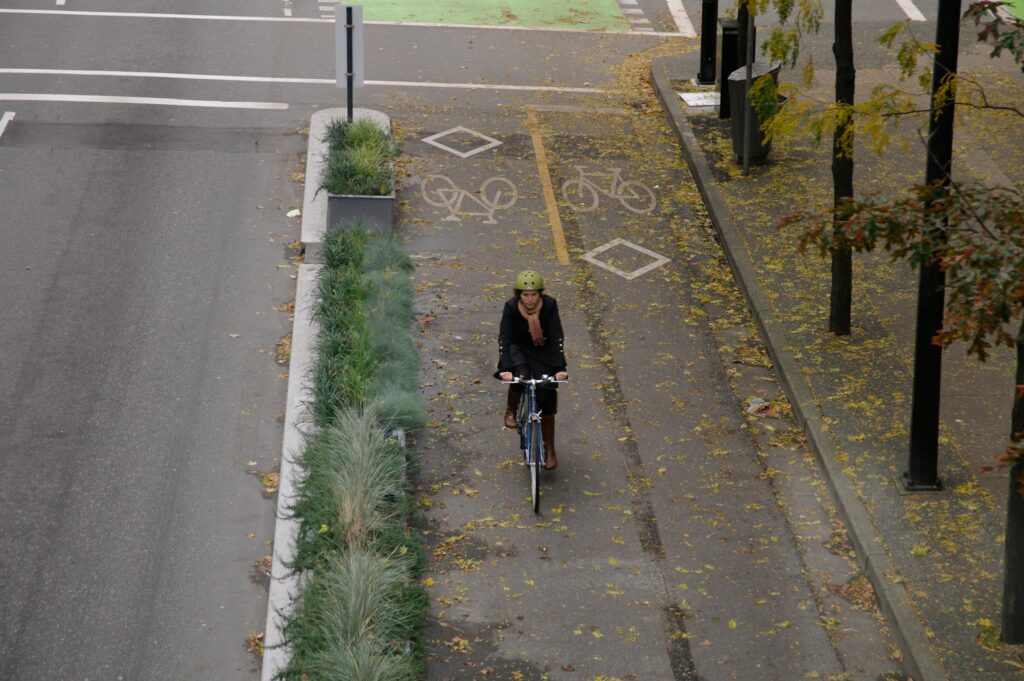Safe riding
There are many opportunities to reduce the chance of a crash or fall before one ever rides with skill and knowledge, just as there are many simple courtesies we can offer to our fellow sidewalk, bike lane, and path users to make outdoor transport more enjoyable.
While many manufacturers like to tout their wide-deck scooters for allowing side-by-side foot positioning, many e-scooter riders will point out that this positioning puts a rider at risk during hard or emergency braking.
Placing one foot behind the other allows a rider to quickly transfer weight to the rear of the scooter when needed, especially important if the scooter jolts from a small pothole or other obstacle not observed in time (this is also why the "two second/ten second" rule is also important - spot obstacles before they become a problem).
There's a famous, worldwide debate around helmets and bicycles.
That debate will continue forever.
What is not up for debate is the increased speed of motorized micromobility devices. Being able to accelerate to and maintain 20mph absolutely warrants helmet use on any e-bike or e-scooter, particularly so on e-scooters due to reduced stability (compared to a bicycle), small wheels, and propensity for models with poor steering geometry and skittish handling.
Helmets that meet US Consumer Product Safety Commission (CPSC) standards for bicycles are acceptable for e-scooters. These helmets may be branded as either bicycle or (non-stunt) skateboard helmets. Such helmets, in a crash, were found (for cyclists) to reduce head injury by 48%, serious head injury by 60%, traumatic brain injury by 53%, face injury by 23%, and death or seriously injured by 34%.1
Keep in mind that a helmet must be fitted properly to work. Wearing a helmet loose, too far back, or in any other ill-fitting configuration defeats its purpose. We greatly recommend the fitment guide from our BikeSafe Program:

It's no fun to be walking on the sidewalk only to be jump scared by someone passing on an e-scooter. Worse yet, getting hit by one can send both parties to the hospital. This controversy alone has resulted in a fair amount of negative press, while the e-scooter community itself - particularly through Reddit and many Facebook groups - frequently lament poor riding etiquette.
It's not difficult to ride respectfully. Follow these golden rules if you must ride on a sidewalk or shared path:
- Don't exceed ~7mph when sharing space - reduce your speed in advance if you see pedestrians ahead.
- Reduce speed even further if you see youths. Children can be unpredictable and it's their nature to be so. You have the ability and responsibility to minimize dangers posed to them when riding an e-scooter.
- Yield the right of way to pedestrians when using their space. It's not just courtesy, it's Florida law as well.
- Call out your presence when passing. Nicely. The first is Florida law, the second is common courtesy.
- Don't ride on sidewalks where municipalities have restricted their use.
All the courtesies of riding a bicycle are the same for e-scooters, with the exception of hand signals: If your e-scooter cannot safely be ridden with one hand (if not, please read our section about scooter front-end geometry), do not remove your hand from the bars to signal.
Otherwise:
- Follow traffic rules, by riding with the direction of bicycle traffic, stopping at stop signs and lights, and yielding accordingly.
- Turn on your lights, even on paths, if your e-scooter's lights have a switch (most turn on automatically).
- Use the turn signal switch if your scooter is equipped with indicator lights.
- Pass others at their speed - reduce your speed when passing other bicycles or scooters so as not to startle others.
- An audible signal when passing will help alert others to your presence, especially if there isn't much traffic. Please do so kindly - don't shout.

Safe scooters
Since 2019, hundreds of personal e-scooters have appeared on the market, following the rental boom that brought them to the public's eye. These scooters range from simple copies of popular designs to costly but well-engineered machines with everything in between.
While the bicycle has been perfected to the point that even "bicycle shaped objects" at big box stores can be expected to handle reasonably (but not necessarily stop!), ideal handling is not always what you'll find on the average production e-scooter.
Caveat emptor.
Many scooters are built with front end steering geometry that actively works against stability, a hot topic in the scooter community (highlighted in particular on this blog and discussed in this Reddit thread),
If you'll excuse us getting nerdy for a moment: Steering stability for bicycles, scooters, motorcycles, and even automobiles is determined by something called "trail". "Trail" refers to how far back the axle shaft of the steering tire is, relative to the pivot line of the steering itself.4 The more trail any vehicle has (up to a point), the more the weight of the vehicle - and in the case of a scooter, its rider - will inherently help influence the front wheel to self-center itself.
Trail is important for a bicycle or a scooter in operation and allows the vehicle to track smoothly. This makes the steering smoother and less susceptible to a minor overcorrection causing a major upset in balance. Proper trail also allows a rider - if necessary - to look backwards or momentarily remove a hand from the handlebar to signal a turn.
While you'll never see a bicycle - other than a purpose-built track or circus bike - built without trail, an alarming number of scooters have very little, if any. Some scooters with cantilevered suspension may also encounter wild changes in trail, if the swing of the arm causes the axle to move significantly backwards or forwards. Many manufacturers fit their scooters with hydraulic steering dampers to compensate, but dampers only mask the issue, they do not solve it.
Most importantly, with a vehicle with such a high center of gravity and small wheels, skittish steering with minimal trail is, quite simply, unsafe and should be avoided.
If you are seeking an e-scooter, our recommendation is to look for manufacturers that clearly publish their front geometry specifications - or scooters highlighted by the community for good steering geometry.
A larger diameter wheel has a better ability to soak up bumps by spanning a wider distance over surface imperfections.
Many scooters have 8" wheels which are only suited to the smoothest of roads and can throw a rider over the handlebars even from a small pothole. 10" has become more commonplace since, though scooters with 12" wheels are also on the market.
Suspension also aids the ability of a harsh jolt to affect only the suspension, rather than transfer those forces to the rider. The rider of an e-scooter influences the overall center of gravity of the machine, and a quick change of this center of gravity from a bump could unsettle the machine enough to cause a crash.
While wider decks are often touted by some manufacturers as a safety feature - a place that one can put both feet side-by-side and thus satisfy peace of mind - many riders will tell you that the deck is encouraging unsafe foot positioning that adds increased risk during hard or emergency stops.
We explain more about this above in the section about foot positioning, but this is something to keep in mind when shopping around.
...don't!
Some models of scooters are offered with a stanchion adapter and conventional bicycle saddle, while other e-scooters are purpose-designed with a saddle in the frame (though these usually don't fold as conveniently as modern e-scooter designs and necessitate bicycle parking).
The adapter stanchions are also available aftermarket for some of the more common models of clone scooter, and bicycle shops open to working on electric scooters should be able to fit these safely.

Safe places
E-scooters are new enough to the transportation mix that they're often orphaned from any dedicated space to accommodate them, leading - directly and indirectly - to the controversy around them.
These problems are mitigated by streets designed - and redesigned - for micromobility in mind.
Protected and separated bike lanes provide a multitude of safety benefits not just to bicycle riders, but to most micromobility devices as well. These dedicated lanes help overcome the dangers of sharing space with motor vehicles, plus they provide a clearly marked, dedicated area for small micromobility vehicles.

These benefits remove much of the ambiguity that leads to where e-scooters are supposed to be ridden. Sidewalk riding often leads to angry pedestrians, while roads - though usually the legal option - open riders to the risks created by automobile drivers; hence why many choose the sidewalk.
Yet, compared to someone on a bicycle, an e-scooter rider is twice as likely to crash on a sidewalk due to street furniture, uneven surface transitions, or sidewalk damage2 that can easily snag the small front wheel of most popular scooters.
By comparison, protected bike lanes are paved with asphalt along with the road, so they're usually just as smooth as the normal roadway. Local bicycle advocates are also likely to be vocal about maintenance and debris removal.
Learn more about protected bike lanes from BikeSafe:

Our definition
To be clear - as the term "e-scooter" can be misinterpreted to be more than one type of mobility device - we are using the US Federal Highway Administration (FHWA) definition for this type of micromobility, namely, "a small, low-speed transportation device that is human- or electric-powered" without pedals and designed with a step-through frame that is not straddled.3
Our position statement
The KiDZ Neuroscience Center has authored a position statement of best practices for entities seeking guidance.
The position statement is available for viewing below and for download.
- https://doi.org/10.1016/j.aap.2018.03.026
- https://doi.org/10.1080/15389588.2021.1913280
- Federal Highway Administration. (n.d.). Micromobility [Fact Sheet]. United States Department of Transportation. https://www.fhwa.dot.gov/livability/fact_sheets/mm_fact_sheet.pdf
- Yes, we know this is related to "rake," which the overall angle of the fork that creates the trail.
